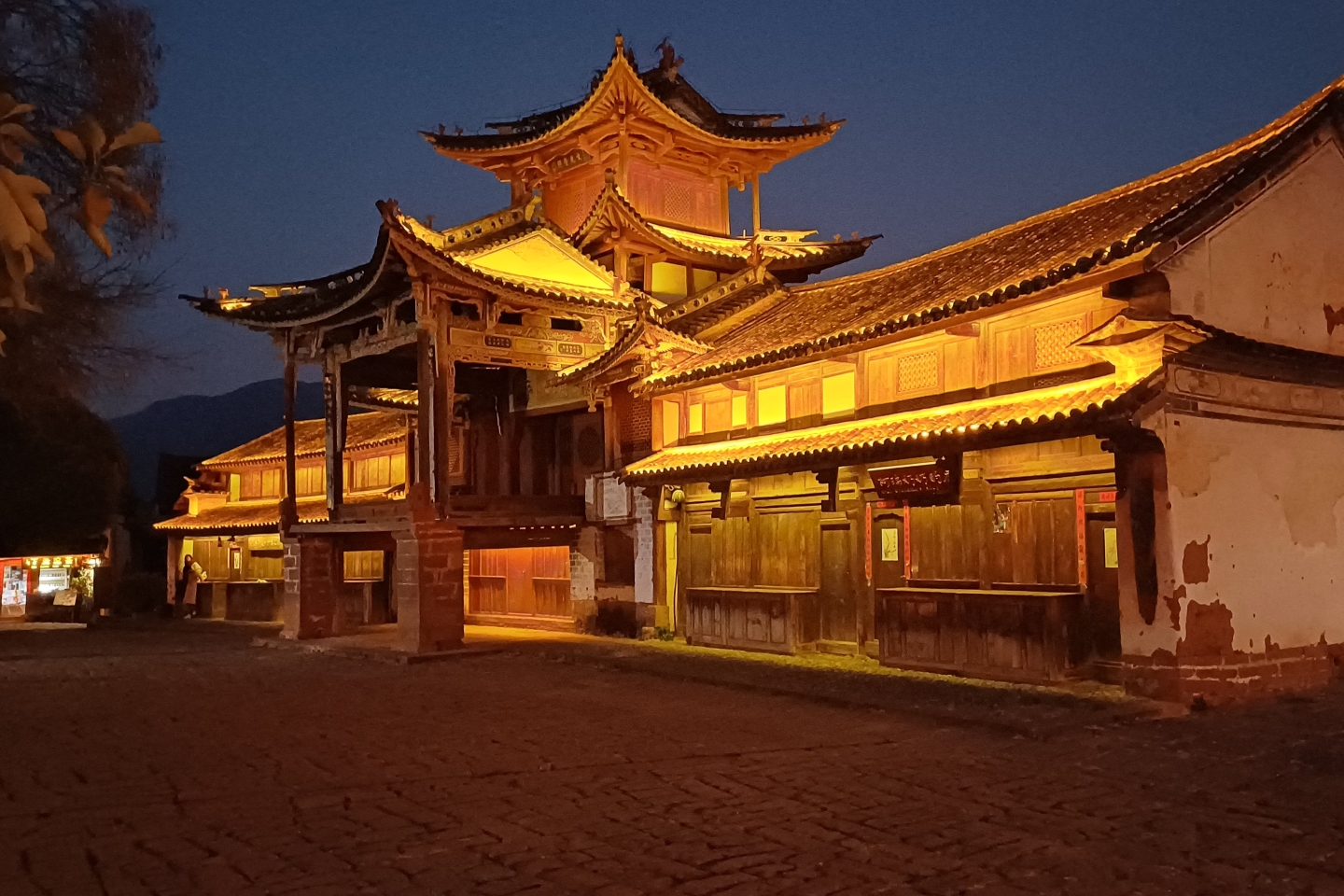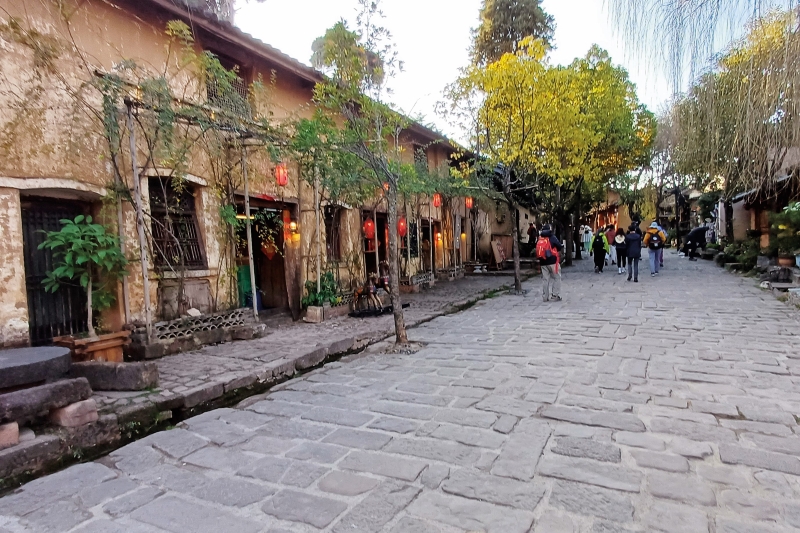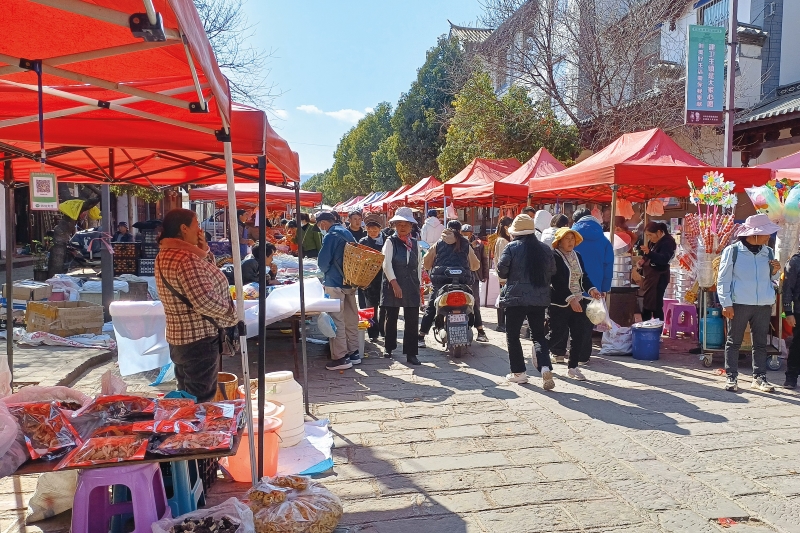
In bygone days, Chinese opera was performed in the square’s open theatre (All photos: Lee Yu Kit)
Less well-known than the Silk Road, which linked the Eastern and Western civilisations of the ancient world, were the southerly routes between Tibet and southern China. These routes existed as early as the Tang Dynasty (7th to 10th centuries) and were in use until the latter half of the 20th century. Collectively, they were called the Ancient Tea Horse Road, or Chamagudao.
Like the Silk Road, the Tea Horse Road was a commercial route, facilitating the trade of not only tea but also other goods, as well as the spread of religions, beliefs and cultures.
The existence of the Tea Horse Road was driven primarily by the Tibetan thirst for tea. They consumed, and still consume, prodigious quantities of it. Tea — considered one of the four pillars of life, along with tsampa (barley), meat and butter — does not grow in the highlands of Tibet and had to be imported.
Tea is thought to have been first drunk several millennia ago in the Yunnan area, from which it spread to become the most widely consumed drink in the world, after water. It is brewed from the leaves of the Camellia sinensis, which is widely planted throughout the world where conditions are appropriate.
On the Tea Horse Road, tea was transported in compressed brick form from the lowlands of Yunnan and Sichuan through mountain roads and high passes to the highlands of Tibet. In exchange, the hardy Tibetan pony was highly prized by the Imperial Chinese military and many thousands made the reverse journey. The smallest cog in the wheel of this commerce was the beifu, or carrier.
shaxi_street.jpg

The male — as well as female and child — beifu who carried the tea were impoverished members of society who could obtain only the lowliest paid work. For them, life offered little choice but to endure the bitter hardships of the tea-porter. They carried as much weight as humanly possible, several times their own body weight, pausing every few steps to rest on T-shaped, metal-tipped walking sticks, which helped them balance their staggering loads.
Many perished from the perils of the journey, from being prey to brigands, exhaustion, harsh weather, illness, accidents and poor nutrition — all for wages just enough to buy a bag of rice or corn.
The Tea Horse Road became a trade route, with the intermingling of many cultures and peoples, as well as commerce in a wide variety of goods. It was overtaken by the development of modern transport and infrastructure, and the Chinese military invasion of Tibet in the mid-20th century.
Towns along the route flourished and prospered with the traffic of people and commerce — and withered when the route died out.
Sections of the original trails still exist, though they have been supplanted by modern transportation. The towns that flourished on the old Tea Horse Road, once remote and difficult to access, are now easily accessible, thanks to modern roads and vehicular travel.
Of the Tea Horse Road towns, the only complete surviving example of a trading town is Shaxi in Yunnan province.
shaxi_fri_market.jpg

Midway between the towns of Dali and Lijiang, Shaxi still has links to the trade that shaped what it is today. It was founded in roughly 700 AD as a market trading town on the Tea Horse Road.
Shaxi has the soporific atmosphere of a small, frontier town, seemingly marooned on a side road bypassed by the superhighway of China’s modernisation drive. The central main street is lined by trees and low buildings on either side. Small businesses, provision shops and restaurants occupy the wooden carved-frontage buildings.
For the last 600 years, there has been a Friday market in Shaxi. Originally held in the main square of the Old Town, the market outgrew the confines of the square and migrated into the main street of the town, where it causes vehicular traffic to be diverted on Fridays.
The ancient market has evolved into a modern street market, with large red canopies set up on either side of the road. Branches veer into the wet market area where vegetables and fresh meat are sold.
The stalls sell a large variety of goods, modern and traditional, everything from shiny kitchenware and utensils to hardware, apparel, shoes and toys, as well as fresh foods. There are sweets, local delicacies, sausages and dried meats, too.
As in centuries past, elderly matriarchs from the ethnic minorities, mainly the Yi and the Bai, sit patiently on the road curbs, with their wares displayed on the side of the road, in the dappled shade of trees. They sell a varied assortment of dried foods — bags of various mushroom and fungi, gnarled nuts, seeds and herbs. Some of the mushrooms, such as the valuable matsutake, sell for thousands of yuan per kilogramme.
An arched gate of earth and wood, built in the late Ming Dynasty, provides access into Shaxi Old Town. The gate has embrasures for defence and observation. Merchants and shops in the town were natural targets for bandits, so the gates were constantly guarded.
square.jpg

Cobbled alleys lead into the main Sideng Square, the heartbeat of the town. It is a large, open space, paved with stones, with a few trees in the centre and surrounded by a row of low wooden buildings.
On one side is the showpiece, the magnificent tiered theatre that dominates the square. People once sat or sprawled in the open area to watch operas performed at the theatre.
Directly opposite the theatre, two fearsome-looking statues stand guard at the entrance to Xingjiao Temple, built during the Ming Dynasty. It was the only Buddhist temple of the Bai minority, the main minority ethnic group in Shaxi. That it is still standing is something of a marvel. In the 20th century, it was commandeered as government quarters. Thus, it was saved from the destruction that befell thousands of other religious buildings across the country during the conflagration of the Cultural Revolution. It is now a museum.
The other buildings on the square were once provision shops and guesthouses for travellers, now replaced by small cafés and shops.
Radiating away from Sideng Square are cobblestone streets lined with small traditional shops and residences. Unlike the glamour and gentrification that have befallen other Tea Horse Road towns such as Dali and Lijiang, much of Shaxi still retains its original character, with residences along the alleys, instead of converted chic cafés, restaurants and dessert shops. Canals of clean running water flow beside many of the tree-lined alleys.
The town is scrupulously clean, free of graffiti or rubbish strewn in the streets and alleys. It is a functioning town; residents occupy many of the buildings, and there are services of a small municipality. Garbage collection trucks play folk music to announce their presence; residents bring out bags of rubbish to fling onto the back of the trucks.
One of the cobbled streets leads to the other major access point to the Old Town, the East Gate.
yuijin_bridge_shaxi.jpg

Beyond the East Gate are the willow trees that weep over the placid Heihui River. A paved path wends to the stone Yuijin Bridge that spans the river. The semicircular arch of the bridge, reflected in the river, describes a perfect circle. The bridge was originally built during the reign of Emperor Kangxi (1654-1722) of the Qing Dynasty, and rebuilt in 1931 after it collapsed.
It was once the main access point to the town, its stones polished by the feet of innumerable travellers and the hooves of their horses. A small sheltered altar beside the bridge houses its guardian deity.
As trade on the Tea Horse Road faded, so did the fortunes of Shaxi. In the mid-20th century, it became increasingly poverty-stricken, with many of the buildings falling into disrepair and dereliction. Its ethnic Bai flavour became increasingly diluted.
In 2001, the Sideng Market Square was placed on the World Monuments Watch List of 100 Most Endangered Sites. A restoration project undertaken in the early 2000s sought to restore and preserve the character of the town, using original materials and methods as far as possible.
The wind is sighing through the willows. Wearing a hat and sunglasses, a young woman with a guitar is singing Chinese love songs beside the bridge, recorded by visitors on their smartphones.
Tourists wander the streets of Old Shaxi, marvelling at this glimpse of an old China — so vastly different from their modern lives, yet inextricably a part of their own identities, for most of the visitors are Chinese.
Shaxi, once an important market town on the vanished Tea Horse Road, has staged a comeback, an aching reminder of a past recent and ancient, yet a world removed.
This article first appeared on July 29, 2024 in The Edge Malaysia.


